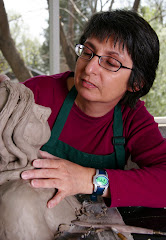
Thursday, September 1, 2011
The Chameleon Contest! And the Winner is....

Friday, August 5, 2011
Can You Say, "Camouflage"?
Saturday, July 9, 2011
Name that Chameleon, Win a Class for Two!

Name Me!
When I chose this photo of a happy chameleon for my postcards for teaching clay sculpture classes, I had no idea how popular s/he would become. People of all ages have remarked that they picked up the postcard because of his (her?) great expression.
Even I still smile when I look at the photo.
Well, it’s time for this joyful Spokeslizard to have a name. Please send me your best suggestions and the author of the name chosen will win a 2-hour sculpture class for two people (includes clay and one firing) at Out of the Fire Sculpture Studio, in Saxapahaw, NC.
Anyone may enter! E-mail your entries to cbiles@triad.rr.com, or find the studio on Facebook: Out of the Fire Clay Sculpture by Cindy Biles. Deadline to enter is August 31, 2011. I'll post the winning name on Facebook and here in September.
Tuesday, June 28, 2011
Summer Fun!

Just finished Summer Fun, in time for the new show at the Saxapahaw Artists Gallery, in Saxapahaw, North Carolina. Members of this cooperative gallery are the featured artists for the month of July. We'll have an opening reception on Friday, July 1, from 6-9PM. There will be wonderful art, food and drink, music, conversation, good times. Hope to see you there!
Friday, June 10, 2011
Mason Stains, Demystified - an article by Jennifer Hoolihan at Highwater Clay
Ceramic Stain Act One
by Jennifer Hoolihan |
On your visits to Highwater Clays, you might have noticed all the brightly colored bags of powder neatly lined up in the stain aisle. Perhaps you were beguiled by the visual display but wondered, what are these? Good question! Read on, and we will provide a little clarity on the wide world of ceramic stains in part one of our tech tip stain series. |
|
Friday, April 8, 2011
New Classes at Out of the Fire Studio!





This is the list so far, but once I figure out my summer schedule, there will be more classes of a bigger variety. FPr example. I would love to work with teens who would like to take a serious sculpture class--experience level would not be that important, just a desire to learn.
Also, I'd love to have classes that go on for 4-6 or 8 weeks. Feedback I've received lately, though, suggests that people prefer not to commit too many days at a time, and I can understand that!
So I'm starting with 2-day classes, where you sculpt one day and come back in two weeks to glaze (or in the case of very young children, paint) the piece after I've fired it.
If there are other classes you would like to see offered, please let me know!
Clay Sculpture for Adults: Why Should Kids have All the Fun?
Picasso said, “Every child is an artist. The problem is how to remain an artist once we grow up.” Let go of self-judgment, have a great time and create something wonderful for your home or garden! We will sculpt during the first class and glaze our magnificent works during the second class, two weeks later. Sculpture tools are provided for use during class. First Session: May 9 and 23 (Mondays), Second Session: June 13 and 27 (Mondays), Third Session: July 14 and 28 (Thursdays). 7-9PM. $45 per session, includes 5 pounds of clay, glazes and firings.
Big Hands, Little Hands—A Great Clay Adventure!
A child and his or her Special Someone will learn a lot and have a lot of fun as they coil, roll and pinch clay to each create a masterpiece! You get to spend quality time with that special young spirit and remember the joy of play as you release your own inner child. We will sculpt during the first class, and glaze or paint during the second class, two weeks later. Sculpture tools are provided for use during class. First Session: June 11 and 25 (Saturdays), Second Session: July 16 and 30 (Saturdays). 10AM-12Noon. $55 per session, includes 6 pounds of clay, glazes, paint, and firings.
Monday, March 28, 2011
Visual Art Exchange Exhibition!

With patience and mutual trust, humans and animals can develop a bond where both parties communicate on an intuitive, or even spiritual, level. Although technology enables people (who have access) to exchange information frequently and instantly, there is still a fundamental human need for direct connection with another living creature. The companion animal lives in the present, accepts us at face value, finds joy in simple pleasures, and offers unconditional love.
Friday, February 25, 2011
Balancing Act







